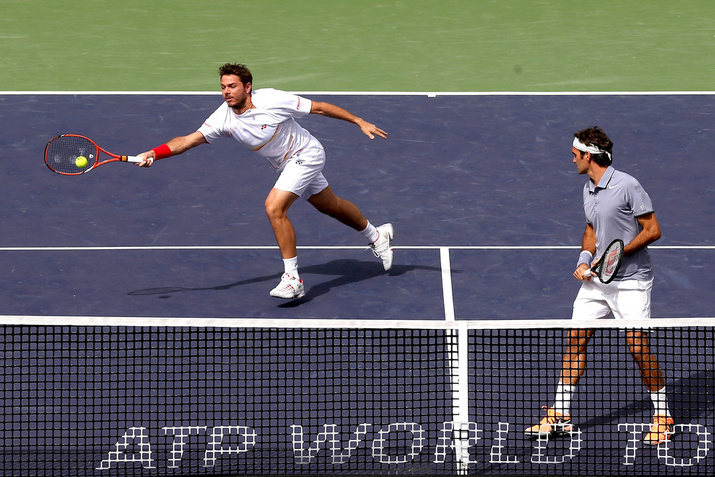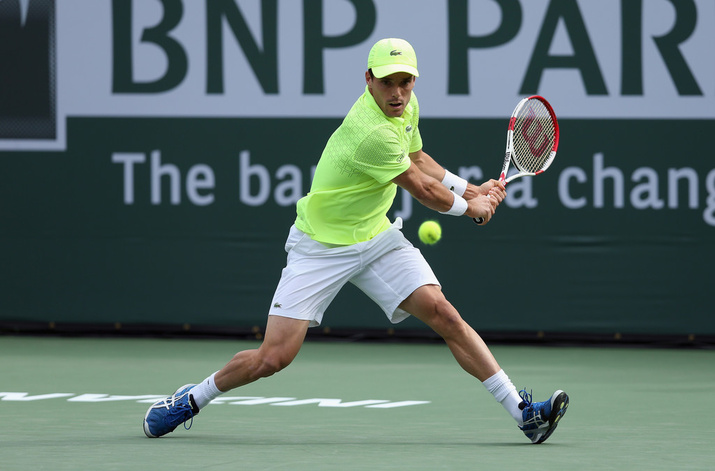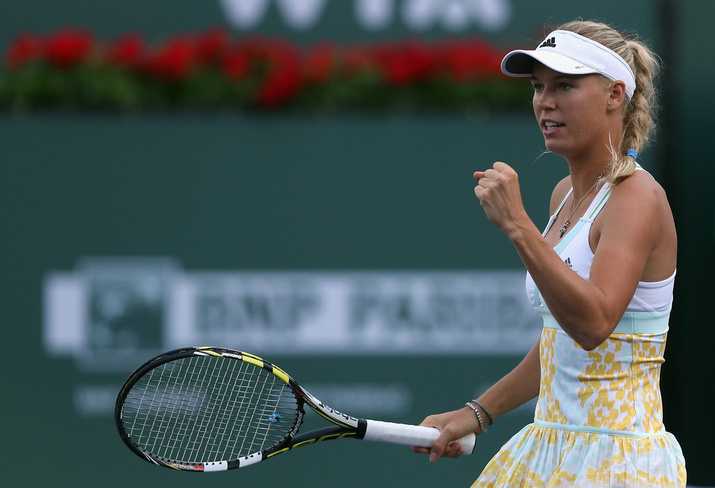Don't miss any stories → Follow Tennis View
FollowBest of Day 3: Federer, Radwanska, Wozniacki, Bouchard Star
Friday in the desert saw few notable surprises as the women’s seeds began play. One of the most intriguing headlines came from doubles, as was the case on Thursday. This time, men’s doubles action turned heads when Olympic gold medalists Roger Federer and Stanislas Wawrinka strode onto Stadium 2. In his first tournament as a major champion and Swiss No. 1, Wawrinka partnered Federer to score an upset over sixth seeds Rohan Bopanna and Aisam-Ul-Haq Qureshi.

Popularly known as the “Indo-Pak Express,” the Indian Bopanna and Pakistani Qureshi have earned praise for competing together despite the long-standing enmity between their nations. But they fell behind the Swiss singles stars at the outset and did not settle into the match until late in the second set. At that stage, the doubles specialists found the clutch serving and pinpoint angles that they needed to force a match tiebreak. The nerve-jangling race to 10 points saw Federer and Wawrinka regroup from an early deficit to score the upset, exploiting their superior first strikes on serve and return. Ahead lies an intriguing second-round match against either Milos Raonic and Ernests Gulbis or Novak Djokovic and Filip Krajinovic.
The Indian Wells men’s doubles draw features many such teams of singles players making a rare foray into a different form of the sport. As Federer and Wawrinka showed, the more familiar pairings of doubles specialists have much to fear from them despite their lesser experience in the format. Doubles showcased Federer’s uncanny touch around the net and the varied placement on his serve. The match also allowed Wawrinka to settle into his first tournament since the Australian Open in a relatively stress-free atmosphere.
Agnieszka Radwanska d. Heather Watson: An unassuming world No. 3, Radwanska usually flies under the radar at events of this magnitude. That probably won’t change if she continues to struggle on serve as much as she did against Watson, not known for her returning prowess. Radwanska won less than half of her service points in a contest of more breaks than holds. She did just enough to dispatch the qualifier in straight sets but not nearly enough to intimidate her rivals.
Varvara Lepchenko d. Daniela Hantuchova: Coming off a right knee injury, Hantuchova could not revive the form that carried her to two Indian Wells titles. Lepchenko capitalized against the 29th seed in the first upset of the women’s draw. The American of Ukrainian origins broke Hantuchova in all but one of her service games and recorded consecutive main-draw victories for the first time since last July. That previous result came at Stanford, so the California climate must agree with Lepchenko.
Marinko Matosevic d. Bradley Klahn: A poor first-serve percentage undermined the American No. 3, who eyed a winnable match against an opponent ranked slightly below him. The opportunity slipped away from Klahn, a 23-year-old California native making his Masters 1000 main-draw debut. By contrast, Matosevic reached his first Masters 1000 quarterfinal in Canada last summer, so he held a massive experience edge over a man with three career main-draw wins at the ATP level. Klahn’s three Challenger titles since last fall have fueled his rankings rise, but he faces a steep learning curve as he adjusts to the ATP Tour.

Roberto Bautista Agut d. Steve Johnson: More may have been expected of Johnson than Klahn this week, despite his lower ranking. Also a California native, the former NCAA star at USC had received a main-draw wildcard after a surprising run to the semifinals of Delray Beach. On this occasion, though, Johnson played more like his ranking of world No. 119 than like an ATP semifinalist. He never found his footing against Bautista Agut, who had reached the second week of the Australian Open and was much the more athletic of the two men. Playing on one of the largest stadiums in the sport probably did not calm Johnson’s nerves. Still, he’ll remember that experience for a long time.
Roberta Vinci d. Madison Keys: Although she received a bye and remains in the top 20, Vinci entered this tournament without a win in 2014. She ended that skid with a surprisingly comfortable win over an American who had impressed in the previous round. Keys has produced inconsistent results this season, however, and her form tumbled from a victory over Tsvetana Pironkova. To do her justice, Vinci frustrates many talented youngsters with her variety and consistency.
Eugenie Bouchard d. Peng Shuai: The Stadium 3 crowd relished their first glimpse of the Canadian teenager who set Melbourne on fire. Surprise Australian Open semifinalist Bouchard showed off both her power and her athleticism in sailing smoothly past the world No. 40 in 63 minutes. The WTA’s top double-fister after Marion Bartoli retired, Peng could make no inroads in return games as Bouchard faced just a single break point. After making this strong statement in one of the draw’s softest sections, Bouchard next targets an upset bid against world No. 10 Sara Errani.
Annika Beck d. Elena Vesnina: The 20-year-old Beck announced herself last fall by reaching her first career final, but her real breakthrough may have come in Doha last month. There, she defeated consecutive top-20 opponents in Bouchard and Samantha Stosur. Continuing that strong span of form in the desert, Beck avenged a loss to the 35th-ranked Vesnina at last year’s US Open.

Caroline Wozniacki d. Bojana Jovanovski: In each of their last four meetings, Jovanovski had won at least one set. The Serb thus had established herself as a thorn in Wozniacki’s side, which intrigued at a tournament where the Dane has excelled. Three times a finalist at Indian Wells, 2011 champion Wozniacki showed how comfortable she feels on the slow hard courts by defusing Jovanovski more easily than in the past. Her consistency tapered in the second set, but she weathered the bursts of shot-making explosiveness that flared too rarely opposite her.
Lauren Davis d. Victoria Azarenka: A foot injury might not sound as serious as an injury to a shoulder, back, or knee. Still, it can derail a player’s entire game by compromising movement and balance. Azarenka found that out the hard way during a severely hampered effort, yielding 12 double faults and often limping along the baseline. She battled to reach a second-set tiebreak after she had looked ready to retire a few games into the match. While Davis deserves credit for finishing her off at that stage, her upset was less spectacular than it looked on paper. It does open the draw for her, however, as well as for rising stars Bouchard and Simona Halep.
Saturday sees a procession of superstars march across Stadium 1. Seeds begin action in the men’s draw, and three of the Big Four will open their campaigns. While Rafael Nadal highlights the night session, Andy Murray and Roger Federer wedge between Li Na and Maria Sharapova during a blockbuster day program. Tomorrow’s recap will be incomplete as we travel to the event, but on-site coverage will start on Sunday as a result.










